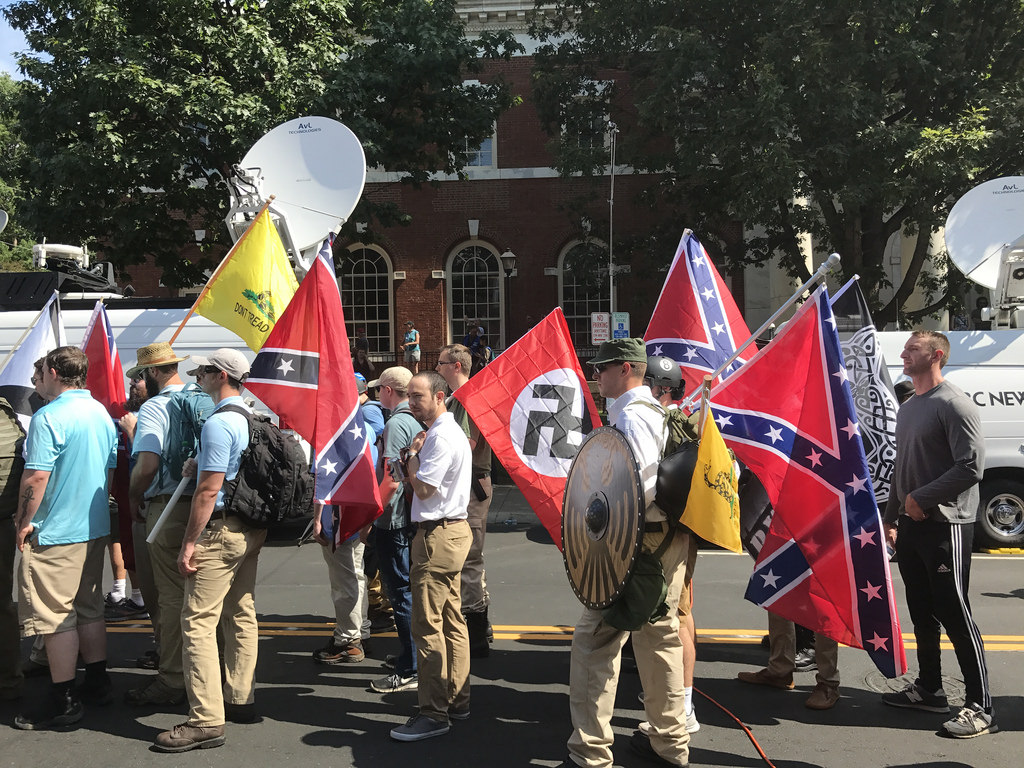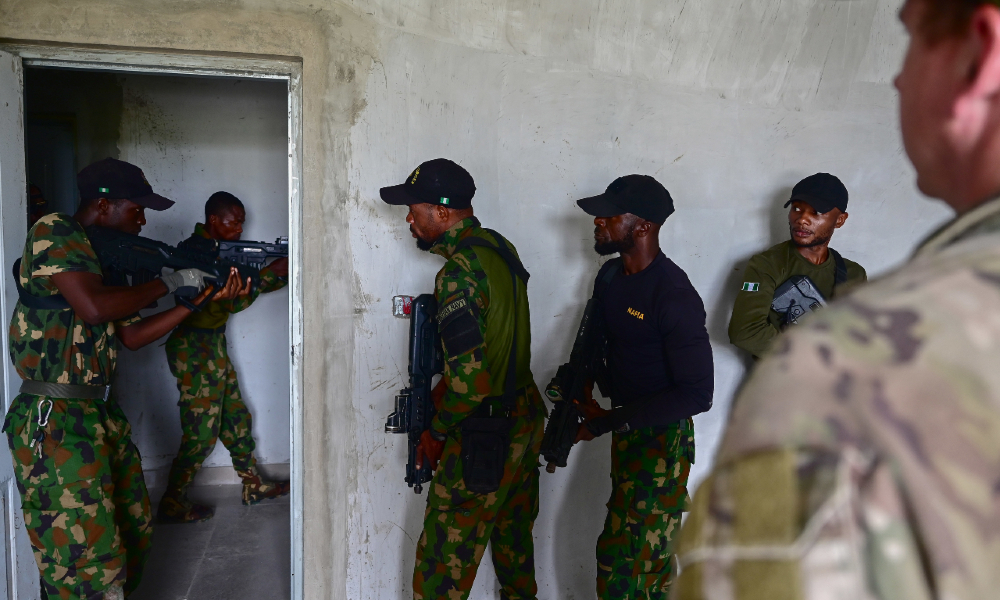Should We Use the ‘T-Word’ for Right-Wing Violence?
This essay draws on a longer piece on the same subject that the author wrote for Foreign Affairs. A second essay with Lawfare looks at the implications of using the "T-Word."

Published by The Lawfare Institute
in Cooperation With

This essay draws on a longer piece on the same subject that the author wrote for Foreign Affairs. A second essay with Lawfare looks at the implications of using the "T-Word."
Just over two months ago, on August 12, 2017, James Alex Fields Jr. drove his car into a crowd of peaceful counter-demonstrators in Charlottesville, killing Heather Heyer, one of the demonstrators. Fields’ act was treated as the crime it was: He was charged with second-degree murder and hit-and-run connected to Heyer’s death, along with several crimes related to the injuries of other victims.
Yet given the political nature of the violence, and given the power of terrorism as a label, many have called for treating Heyer’s death as terrorism. Fields championed white supremacist, neo-Nazi ideas—virulent ideas just as hateful as jihadism. Moreover, Fields’ vehicle attack resembles nothing less than those in Barcelona, Berlin, London, Nice, and other cities in the past two years.
President Trump has notoriously avoided harsh condemnations of right-wing violence despite being quick to criticize anything similar on the Islamist end. But others in his administration do not share his hesitation. Attorney General Jeff Sessions labeled Fields’ attack “domestic terrorism,” which federal law defines as trying to intimidate a civilian population or affect government policy through violence in an area of U.S. territorial jurisdiction. On Lawfare, Mary McCord, the former acting assistant attorney general for national security, made a powerful case that “our federal criminal laws recognize domestic terrorism for what it is: the moral equivalent of international terrorism.
Fields’ attack is not the first time that right-wing violence has raised questions about the terrorism label. After the 2015 attacks on a Planned Parenthood clinic in Colorado Springs and a black church in Charleston, demands to treat right-wing violence as terrorism grew loud. A December 2015 YouGov poll found that 52 percent of Americans thought the Planned Parenthood attack was terrorism, and civil rights activists widely criticized the fact that few media outlets were calling Dylann Roof, the perpetrator of the Charleston massacre, a terrorist.
Some voices have also called for declaring as terrorism the Las Vegas mass shooting, which so far seems to have no link to either a foreign or domestic radical group. These observers argue that even though the shooter, Stephen Paddock, lacked a political motive and thus falls short of the “technical definition of terrorist…. By definition, he terrorized [the innocent crowd in Vegas].” However, the FBI has maintained the position of its original statement that “we have determined, to this point, no connection with an international terrorist group.”
For the sake of consistency, we should also throw left-wing violence into the rhetorical fray, though doing so risks equating minor hoodlums with major thugs. Left-wing groups such as “Antifa” seem to brawl rather than kill: Their violence consists mainly of street fighting against right-wing demonstrators, including largely peaceful ones (the justification being that Antifa has deemed them fascists). The last major cycle of left-wing violence was in the 1970s, when groups such as the Weather Underground tried to bomb America into a revolution. So, put the left-wingers into the argument, but recognize that for now at least the danger they pose is far more limited.
Although many definitions of terrorism exist, the most prominent make little differentiation about the cause that violence serves; whether it is the Klan or Al Qaeda, the specific agenda is not what counts. But both the political baggage that comes with the terrorism label and American public perceptions make it far easier to use the t-word when discussing foreign groups than when describing domestic ones.
Bruce Hoffman, one of the world’s foremost experts on terrorism, defines terrorism as organized political violence (or the threat of it) by a sub-state group with a goal of having a broader psychological impact. U.S. government definitions follow a similar logic: The State Department contends that terrorism is “the unlawful use of force and violence against persons or property to intimidate or coerce a government, the civilian population, or any segment thereof, in furtherance of political or social objectives.” Whether aiming to kill non-Muslims or non-whites is not relevant—what matters is the nature of the act, not the particular agenda behind it.
With 9/11 dominating the thinking on terrorism, some might dismiss white supremacist and like-minded violence as a lesser threat unworthy of the terrorism label, but in the post-9/11 United States, non-jihadist terrorists are as dangerous as jihadists. Although the right-wing category encompasses many disparate groups—including white nationalists, neo-Nazis, neo-Confederates, Sovereign Citizens, anti-abortion zealots, anti-Muslim and anti-immigrant groups, Christian Identity believers, and related fanatics—they collectively form a serious threat to Americans.
Since 9/11, right-wing violence has killed 68 people compared to 95 by jihadists; the jihadist figure would be more than halved (and lower than right-wing murders) if the 2016 shooting of 49 people at a gay night club in Orlando were excluded. The year 2016 was the bloodiest year for domestic extremists since 1995, when the right-wing radical Timothy McVeigh killed 168 people in his bombing of a federal building in Oklahoma City. Since the election of Donald Trump, right-wing violence has soared. In the 34 days following the vote, the Southern Poverty Law Center documented 1,094 bias-related incidents, and 37 percent of incidents involved Trump or his campaign slogans.
Complicating this phenomenon further, many of those involved in right-wing violence are not directly tied to a particular group. Fields, for example, bore the insignia of the neo-Nazi group Vanguard America, but the group does not claim him as one of their own. Like an array of jihadist groups, numerous right-wing organizations are tiny and prone to splintering. However, many—often thousands—of individuals have at least a limited association with some distinct, organized groups.
The legal framework is also complicated and offers little help. Domestic terrorism is not an independent federal crime, in part because there is no official list of domestic terrorist groups. The State Department maintains a list of “Foreign Terrorist Organizations” that tells law enforcement, businesses, and ordinary citizens which groups are illicit even if they agree with the cause as a whole. One of the all-important material support statutes uses this list as part of its criteria for when support for terrorism is occurring. To treat domestic terrorism like international terrorism, the United States would need a separate “Domestic Terrorist Organization” list, presumably compiled by the Department of Homeland Security and the Federal Bureau of Investigation—the federal agencies that currently handle matters that might fall into the category of domestic terrorism—with input from other agencies.
That task is burdensome: Determining who to put on the list would be tricky, as many of the activities that characterize extremist domestic groups—such as encouraging hateful beliefs—are protected as free speech. Also, the government would have to disentangle the domestic and foreign lists if there are groups at home that have no real foreign links but are fanboys of foreign groups such as the Islamic State. Making this more complex, some states do have domestic terrorism laws. Alabama, Arizona, and New York have prosecuted ISIS cases as state terror cases because the feds either didn’t want to or didn’t have enough evidence. So, to do it right, you’d have to be sure that state and federal laws were not working at cross-purposes.
Even if the United States developed a federal statute and an associated list of groups, there is no immediate legal reason to use a terrorism charge unless other legal means do not offer sufficient prosecutorial power, resources or other advantages. In general, the U.S. system gives the states, not the federal government, responsibility for punishing violent crimes. There is no general federal murder statute, for example. To qualify for a federal response, the issue must be a national one, occurring where no one state has clear jurisdiction and thus, requiring cross-state authority and federal resources. That’s why when a U.S. citizen abroad might be a victim of terrorism, the FBI investigates.
In addition, several laws enable the federal government to play a role in terrorism-like cases without calling it terrorism. The Fair Access to Clinic Entrances Act, for example, gives the FBI some responsibility for securing abortion clinics, enabling them to investigate potential threats. Federal hate crime statutes can be invoked against violent white supremacists. These laws can be as tough as anything we’d see if terrorism were made a crime, with some carrying the federal death penalty. Dylan Roof, who murdered nine black churchgoers in Charleston in 2015 was convicted of 33 federal charges, including hate crimes, but not terrorism. Nevertheless, he is on death row.
Ironically, right-wing violence may be having a bigger political impact on the United States even though we pay more attention to jihadist terrorism. Because of its foreign link, jihadist violence brings Americans together in the face of tragedy—we often evoke the days after September 11 as a time of national unity in the face of horror. But left- and especially right-wing violence is driving us apart. On the left, the killing is minimal, but images of Antifa and other violence are used to bolster the perception that Trump’s opponents are extreme and committed to stopping legitimate speech and protest. The impact is far greater on the right because of the scope and scale of the violence. Right-wing violence is usually in the name of a cause—racism, anti-abortion, gun rights, opposition to migrants, and so on—that at least some Americans support, even if the more mainstream groups vehemently reject violence. Over 15 percent of Americans believe that abortion should be illegal in all cases, for example. But comparatively few have ever taken up arms in support of that cause. In 2016 polls, meanwhile, most white people believed that anti-white bias was a bigger problem than anti-black bias, despite outcomes for white Americans exceeding those of black Americans on almost every metric. Violent white supremacists thus poke at bigger political wounds than do jihadists, with many Americans sympathizing for the cause, even if they reject the violent means.
That problem is compounded by the fact that Americans are much more comfortable calling some types of political violence “terrorism” than others because the terrorism label carries normative weight. It suggests that both the person’s actions and their cause are beyond the pale. It is understandable that peaceful anti-abortion voices don’t want to be lumped in, even by very loose association, with anything smacking of terrorism.
***
This array of factors makes it hard to broaden the use of the terrorism label beyond foreign-linked groups. The definitions are all about actions, not the ideology behind it, but most non-experts lump the two together, and politics inevitably shape how we approach this problem. As terrorism analyst Brian Jenkins observed in 1981, “terrorism is what the bad guys do.” Over 35 years later, that’s still where we are.


.jpeg?sfvrsn=96471529_5)


